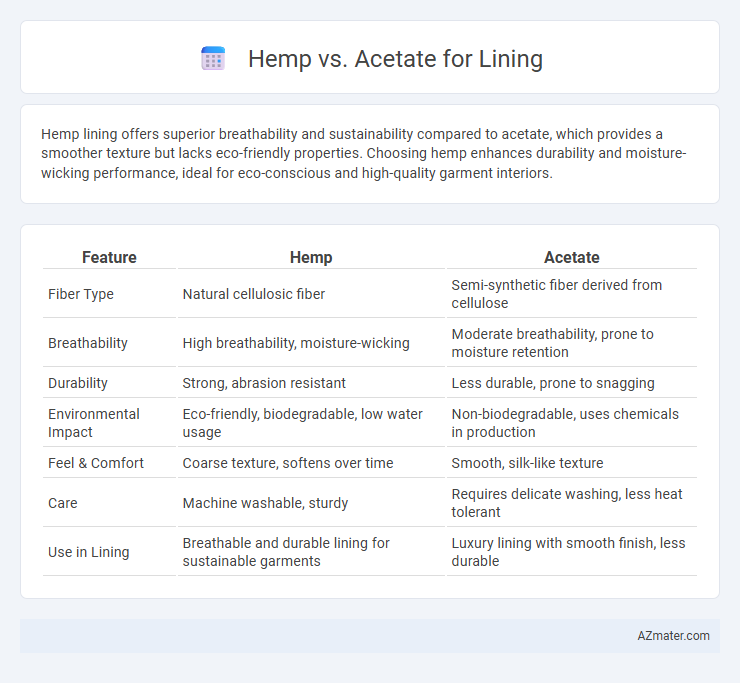Hemp lining offers superior breathability and sustainability compared to acetate, which provides a smoother texture but lacks eco-friendly properties. Choosing hemp enhances durability and moisture-wicking performance, ideal for eco-conscious and high-quality garment interiors.
Table of Comparison
| Feature | Hemp | Acetate |
|---|---|---|
| Fiber Type | Natural cellulosic fiber | Semi-synthetic fiber derived from cellulose |
| Breathability | High breathability, moisture-wicking | Moderate breathability, prone to moisture retention |
| Durability | Strong, abrasion resistant | Less durable, prone to snagging |
| Environmental Impact | Eco-friendly, biodegradable, low water usage | Non-biodegradable, uses chemicals in production |
| Feel & Comfort | Coarse texture, softens over time | Smooth, silk-like texture |
| Care | Machine washable, sturdy | Requires delicate washing, less heat tolerant |
| Use in Lining | Breathable and durable lining for sustainable garments | Luxury lining with smooth finish, less durable |
Introduction to Lining Materials: Hemp vs Acetate
Hemp lining offers natural breathability, moisture-wicking properties, and sustainable durability, making it ideal for eco-friendly textile applications. Acetate lining provides a smooth, silky texture with excellent drape and a glossy finish, commonly used in high-end fashion for its luxurious appearance. Choosing between hemp and acetate lining depends on prioritizing either sustainability and breathability or aesthetic appeal and softness.
What is Hemp Lining?
Hemp lining is an eco-friendly textile made from the fibers of the hemp plant, known for its durability, breathability, and natural resistance to mold and mildew. Unlike acetate linings, which are synthetic and less breathable, hemp provides superior moisture-wicking properties and sustainability benefits, making it ideal for environmentally conscious fashion. Its strong, biodegradable fibers contribute to long-lasting garment structure without compromising comfort or ventilation.
What is Acetate Lining?
Acetate lining is a smooth, silky fabric made from cellulose fibers derived from wood pulp or cotton waste, commonly used in garment linings for its luxurious feel and excellent breathability. It resists shrinking and stretching, providing a stable structure that enhances comfort and appearance in suits, jackets, and dresses. The material's natural moisture-wicking properties make acetate lining a popular choice for maintaining freshness and durability in high-quality clothing.
Environmental Impact: Hemp vs Acetate
Hemp lining offers a significantly lower environmental impact compared to acetate due to its renewable nature and minimal water and pesticide requirements during cultivation. Acetate production involves intensive chemical processing using cellulose from wood pulp, contributing to higher energy consumption and chemical waste. Choosing hemp lining reduces carbon footprint and enhances biodegradability, aligning with sustainable textile manufacturing goals.
Fabric Breathability and Comfort Comparison
Hemp lining offers superior breathability due to its natural fiber structure, which enhances air circulation and moisture-wicking properties, making it ideal for warm climates and active wear. Acetate lining, while smooth and luxurious, tends to trap heat and moisture, reducing overall comfort in hot or humid conditions. Choosing hemp over acetate significantly improves fabric ventilation and comfort, especially for prolonged wear.
Durability and Longevity of Hemp and Acetate Linings
Hemp linings offer superior durability and longevity compared to acetate due to their natural strength and resistance to wear, making them ideal for high-use garments. Acetate linings tend to degrade faster, especially under frequent washing and exposure to heat, leading to reduced lifespan. Hemp's robust fibers maintain structural integrity over time, resulting in longer-lasting, sustainable garment linings.
Moisture Absorption and Odor Resistance
Hemp lining offers superior moisture absorption due to its natural fibers, which wick away sweat and help maintain dryness, making it ideal for breathable garment interiors. Acetate linings, while smooth and luxurious, tend to retain moisture and lack effective odor resistance, resulting in potential discomfort during prolonged wear. Hemp's inherent antimicrobial properties further enhance odor resistance, ensuring a fresher lining compared to synthetic acetate materials.
Allergies and Skin Sensitivity Considerations
Hemp fabric offers hypoallergenic properties and breathability, making it an ideal lining choice for individuals with sensitive skin or allergies, as it resists mold and mildew buildup that can irritate skin. Acetate linings, while smooth and lustrous, are synthetic and may cause irritation or allergic reactions in people with chemical sensitivities due to their non-breathable nature. Selecting hemp lining reduces the risk of skin inflammation and enhances comfort by promoting airflow and moisture-wicking, which is crucial for allergy-prone users.
Applications in Fashion and Textiles
Hemp lining offers natural breathability, moisture-wicking, and durability prized in sustainable fashion and eco-friendly textile production. Acetate lining provides a smooth, silky feel with vibrant color retention, commonly used in high-end garments for its luxurious finish and comfort against the skin. Both materials serve distinct roles: hemp supports organic, ethical apparel trends, while acetate enhances aesthetic appeal and tactile smoothness in designer clothing.
Choosing the Best Lining: Factors to Consider
Choosing the best lining between hemp and acetate involves evaluating factors such as breathability, durability, and environmental impact. Hemp offers superior moisture-wicking properties and biodegradability, making it ideal for eco-conscious consumers seeking natural fiber linings. Acetate provides a smooth, glossy finish with excellent drape and resistance to wrinkles but lacks the sustainability benefits of hemp.

Infographic: Hemp vs Acetate for Lining
 azmater.com
azmater.com